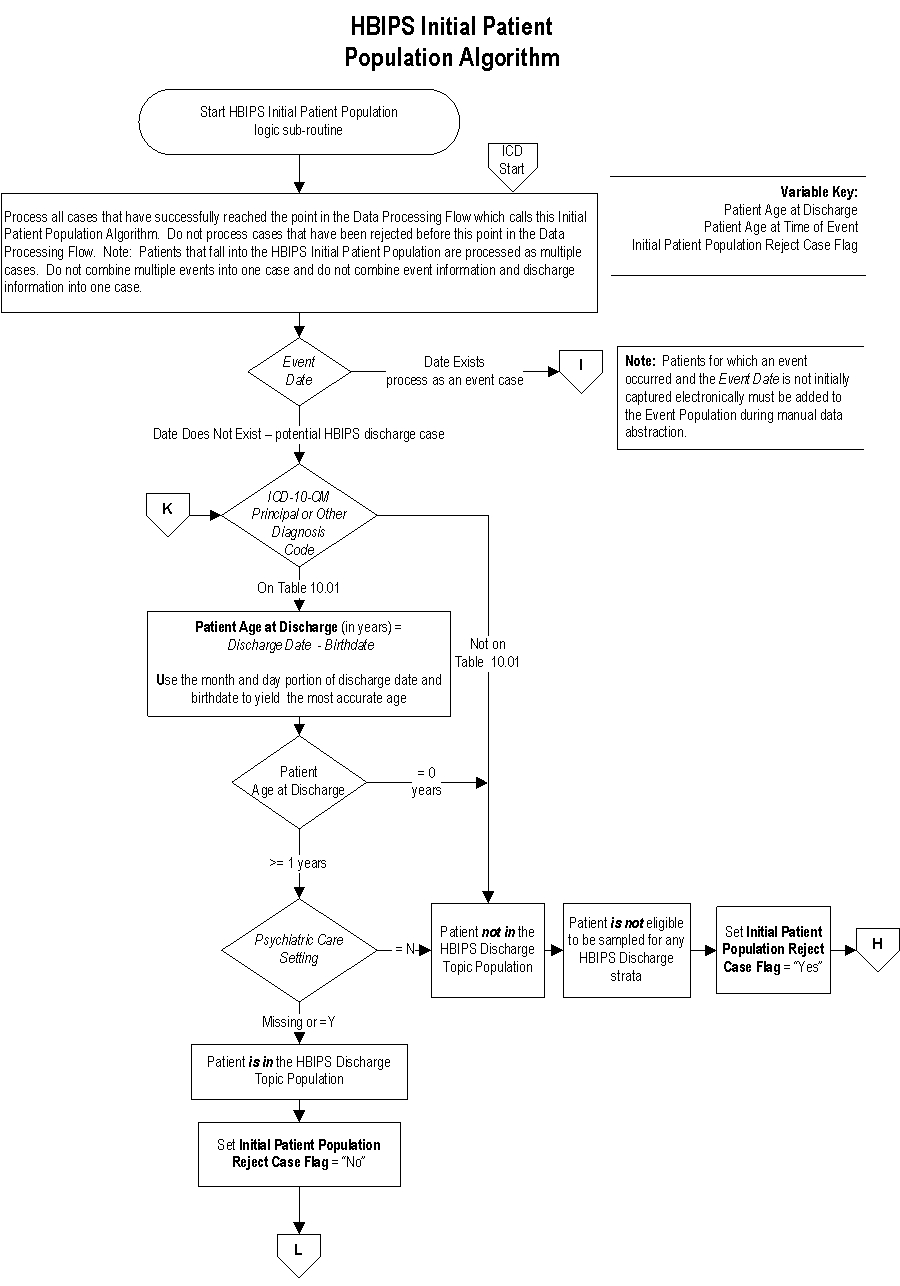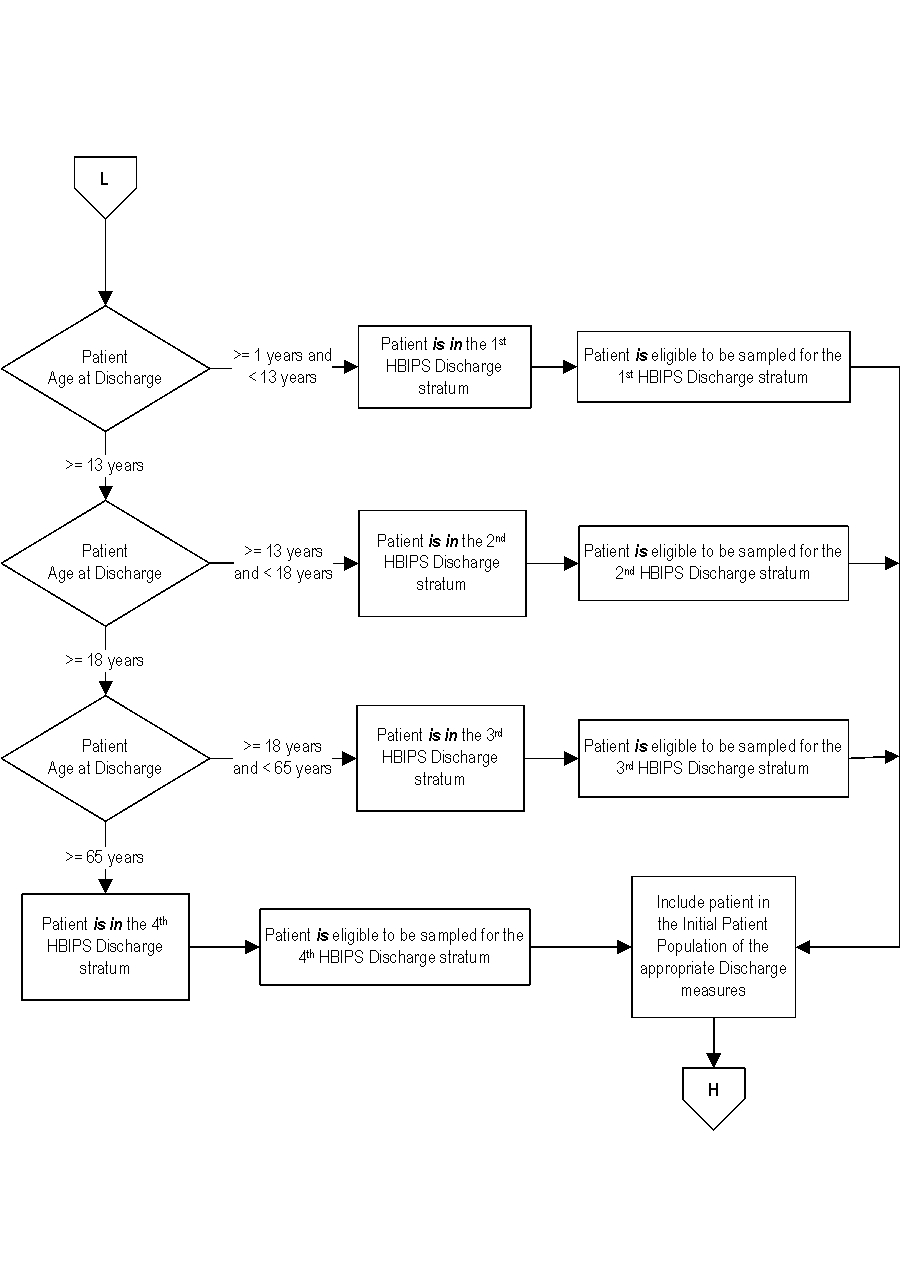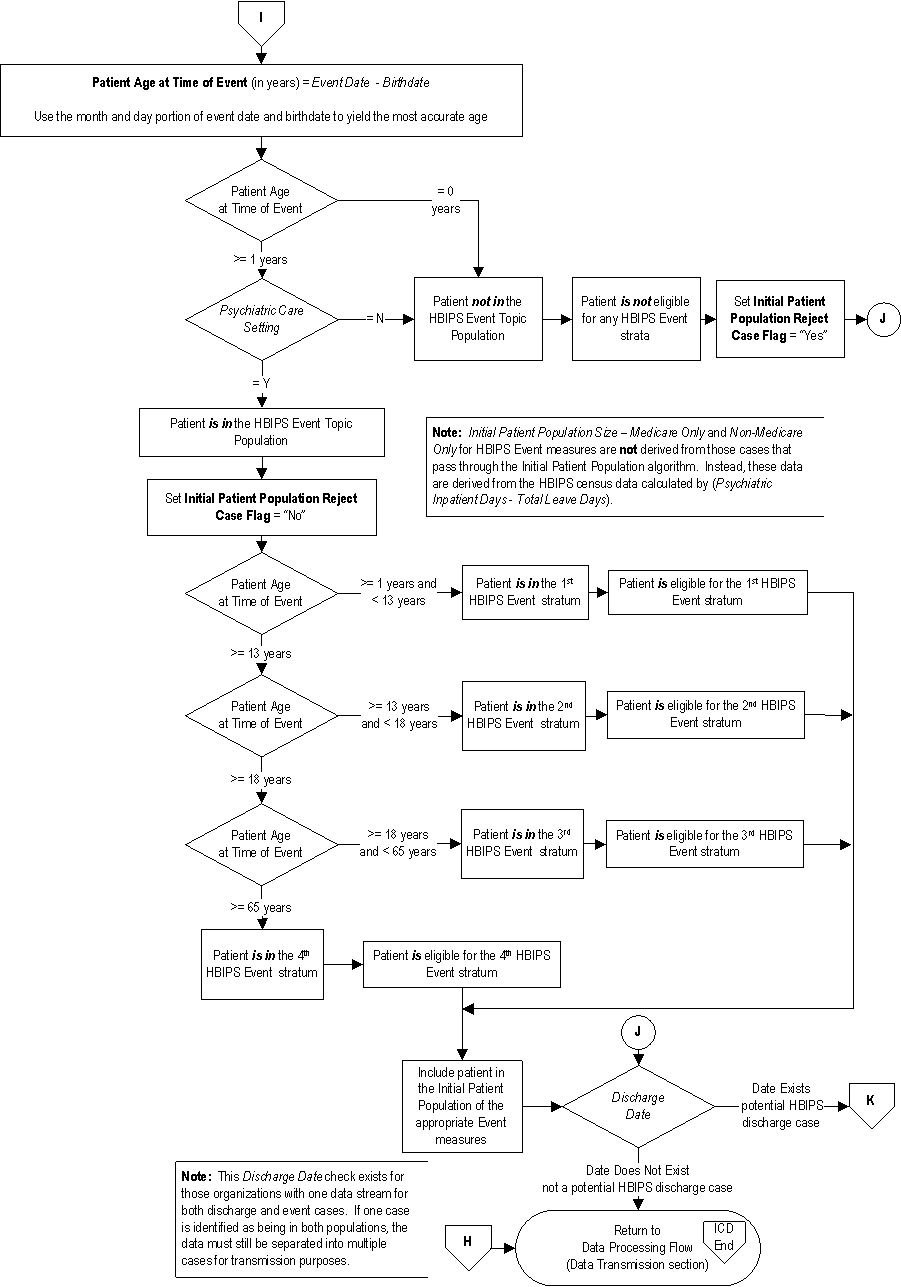Hospital-Based Inpatient Psychiatric Services (HBIPS) Measure Set Initial Patient Population
The HBIPS measure set is unique in that there are two distinct Initial Patient Populations within the measure set, one for the discharge measures (HBIPS-1, HBIPS-4, HBIPS-5, HBIPS-6, and HBIPS-7) and the other for event measures (HBIPS-2 and HBIPS-3).
Initial Patient Population for Discharge Measures (HBIPS-1, HBIPS-4, HBIPS-5, HBIPS-6, and HBIPS-7)
The general population of the HBIPS discharge measures can be identified by using four data elements that are common to the discharge performance measures in the HBIPS set:
- ICD-10-CM Principal Diagnosis Code or ICD-10-CM Other Diagnosis Codes
- Discharge Date
- Birthdate
- Psychiatric Care Setting
The HBIPS Discharge Topic Population is defined as patients discharged from the Psychiatric Care Setting with an ICD-10-CM Principal or Other Diagnosis Code for Mental Disorders as defined in Appendix A, Table 10.01 and a Patient Age at Discharge (
Discharge Date -
Birthdate) >= 1 year.
There are four distinct strata within the HBIPS Discharge Topic Population; each is identified by a specific age range. The patients in each stratum are counted in the HBIPS Initial Patient Population for discharge measures of multiple measures.
| Discharge Measures |
Age Strata |
Initial Patient Population definition |
| HBIPS-1a, 4a, 5a, 6a, and 7a (overall measures) |
Age greater than and equal to 1 year |
The count of all patients in strata 1, 2, 3, and 4 |
| HBIPS-1b, 4b, 5b, 6b, and 7b |
Age 1 year through 12 years |
The count of all patients in stratum 1 |
| HBIPS-1c, 4c, 5c, 6c, and 7c |
Age 13 years through 17 years |
The count of all patients in stratum 2 |
| HBIPS-1d, 4d, 5d, 6d, and 7d |
Age 18 years through 64 years |
The count of all patients in stratum 3 |
| HBIPS-1e, 4e, 5e, 6e, and 7e |
Age greater than and equal to 65 years |
The count of all patients in stratum 4 |
Patients discharged from the hospital with an ICD-10-CM Principal or Other Diagnosis Code for Mental Disorders as defined in Appendix A, Table 10.01 are included in one of the HBIPS Strata Initial Populations for discharge measures and are eligible to be sampled if they have:
Discharge Stratum 1 Age 1 year through 12 years stratum A Patient Age at Discharge (
Discharge Date -
Birthdate) >= 1 year and < 13 years
Discharge Stratum 2 - Age 13 years through 17 years stratum A Patient Age at Discharge (
Discharge Date -
Birthdate) >= 13 years and < 18 years
Discharge Stratum 3 - Age 18 years through 64 years stratum A Patient Age at Discharge (
Discharge Date -
Birthdate) >= 18 years and < 65 years
Discharge Stratum 4 - Age greater than and equal to 65 years stratum A Patient Age at Discharge (
Discharge Date -
Birthdate) >= 65 years
Initial Patient Population for Event Measures (HBIPS-2 and HBIPS-3)
The population of the HBIPS event measures can be identified by using two data elements that are common to the event performance measures in the HBIPS set:
- Event Date
- Psychiatric Care Setting
The HBIPS Event Topic Population (common to all HBIPS event measures) is defined as patients with an event (Event Date exists) while they are in the hospital with a Patient Age at Time of Event (Event Date -
Birthdate) >= 1 year and the patient was in a Psychiatric Care Setting (=Y) when the event occurred. There are four distinct strata or sub-populations within the HBIPS Event Topic Population, each identified by a specific age range. The patients in each stratum are counted in the HBIPS Initial Patient Population for event measures of multiple measures.
| Event Measures |
Age Strata |
Initial Patient Population definition |
| HBIPS-2a and 3a (overall measures) |
Age greater than and equal to 1 year |
The count of all patients in strata 1, 2, 3, and 4 |
| HBIPS-2b and 3b |
Age 1 year through 12 years |
The count of all patients in stratum 1 |
| HBIPS-2c and 3c |
Age 13 years through 17 years |
The count of all patients in stratum 2 |
| HBIPS-2d and 3d |
Age 18 years through 64 years |
The count of all patients in stratum 3 |
| HBIPS-2e and 3e |
Age greater than and equal to 65 years |
The count of all patients in stratum 4 |
Patients for which an event occurs (Event Date exists) while in a Psychiatric Care Setting (=Y) in the hospital are included in one of the Strata Initial Populations for the event measures. There is no sampling for the HBIPS event measures. All patients in the Initial Population for HBIPS event measures are automatically sampled.
Event Stratum 1 Age 1 year through 12 years stratum A Patient Age at Time of Event (Event Date -
Birthdate) >= 1 year and < 13 years
Event Stratum 2 - Age 13 years through 17 years stratum A Patient Age at Time of Event (Event Date -
Birthdate) >= 13 years and < 18 years
Event Stratum 3 - Age 18 years through 64 years stratum A Patient Age at Time of Event (Event Date -
Birthdate) >= 18 years and < 65 years
Event Stratum 4 - Age greater than and equal to 65 years stratum A Patient Age at Time of Event (Event Date -
Birthdate) >= 65 years



Sample Size Requirements
Note For Joint Commission purposes, the HBIPS measure set is not included in the aligned Global Sampling methodology. All patients meeting the definition of the HBIPS Initial Patient Populations are eligible to be sampled, abstracted, and transmitted to the Joint Commission's Data Warehouse.
Sample Size Requirements for HBIPS Discharge Measures (HBIPS-1, HBIPS-4, HBIPS-5, HBIPS-6, and HBIPS-7)
Hospitals that choose to sample have the option of sampling quarterly or sampling monthly. A hospital may choose to use a larger sample size than is required. Hospitals whose Initial Patient Population size is less than the minimum number of cases per quarter/month for the stratum cannot sample that stratum.
Regardless of the option used, hospital samples must be monitored to ensure that sampling procedures consistently produce statistically valid and useful data. Because the sample for a measure set will rarely be equal to the effective sample due to exclusions and contraindications, hospitals selecting sample cases MUST submit AT LEAST the minimum required sample size.
The following sample size tables for each option automatically build in the number of cases needed to obtain the required sample sizes. For information concerning how to perform sampling, refer to the Population and Sampling Specifications section in this manual.
Quarterly Sampling
For hospitals selecting sample cases for the HBIPS discharge measures, a modified sampling procedure is required. Hospitals selecting sample cases for this set must ensure that each individual stratum's population and effective quarterly sample size meets the following conditions:
- Select within each of the four individual measure strata. The effective quarterly sample size within a stratum is at least 44 cases per quarter. Cases are placed into the appropriate stratum based upon the patient's age.
- The required quarterly sample size is at least 20% of the stratum population for the quarter.
Quarterly Sample Size
Based on Initial Patient Population for the HBIPS Discharge (HBIPS-DSC) Measures
Monthly Sampling
For hospitals selecting sample cases for HBIPS discharge measures, a modified sampling procedure is required. Hospitals selecting sample cases for this set must ensure that each individual strata population and effective monthly sample size meets the following conditions:
- Select within each of the four individual measure strata. The effective monthly sample size within a stratum is at least 15 cases per month. Cases are placed into the appropriate stratum based upon the patient's age.
- The required monthly sample size is at least 20% of the stratum population for the month.
Monthly Sample Size
Based on Initial Patient Population for the HBIPS Discharge (HBIPS-DSC) Measures
Sample Size Examples
All sampled strata in HBIPS should be used in the calculation of all HBIPS discharge measures. All of the HBIPS discharge measures' specific exclusion criteria are used to filter out cases that do not belong in the measure denominator. Using HBIPS-1b as an example, include cases covering all sampled strata, although the measure-specific exclusion criteria would only allow cases with an age of 1 year through 12 years to be included in the denominator.
- Quarterly sampling:
When applicable, larger hospitals must also abide by the required quarterly sample sizes for the four individual measure strata a minimum of 44 or 20% of population required sample cases per stratum when Initial Patient Population size is 44 or greater.
- The HBIPS Initial Patient Population sizes for a hospital are 5, 100, 221, and 876 patients for each stratum respectively per quarter. The required quarterly sample sizes would be 5, 44, 45, and 176.
- The 1st stratum is less than the minimum required quarterly sample size, so 100% of this stratum is sampled.
- The 2nd stratum has 100 patients per quarter, which falls in the average quarterly population size of 44 to 220 patients, so 44 cases are sampled.
- The 3rd stratum has 221 patients per quarter, which requires a 20% sample size, of 45 cases (twenty percent of 221 equals 44.2 rounded to the next highest whole number = 45).
- The 4th stratum has 876 patients per quarter, which is more than the maximum condition, so a minimum of 176 cases are required to be sampled.
- Monthly sampling:
When applicable, larger hospitals must also abide by the required monthly sample sizes for the four individual measure strata a minimum of 15 required sample cases per stratum when Initial Patient Population size is 15 or greater.
- The HBIPS Initial Patient Population sizes for a hospital are 5, 45, 294 and 400 patients respectively in July. The required monthly sample sizes would be 5, 15, 59, and 60.
- The 1st stratum is less than the minimum required monthly sample size, so 100% of this stratum is sampled.
- The 2nd stratum has 45 patients per month, which falls in the average monthly population size of 15 to 75 patients, so 15 cases are sampled.
- The 3rd stratum has 294 patients per month, which requires a 20% sample size, of 59 cases (twenty percent of 294 equals 58.8 rounded to the next highest whole number = 59).
- The 4th stratum has 400 patients per month, which is more than the maximum condition, so a minimum of 60 cases are required to be sampled.
Sampling Requirements for HBIPS Event Measures (HBIPS-2 and HBIPS-3)
The measures in HBIPS-EVT (HBIPS-2 and HBIPS-3) are not eligible for sampling and will use the entire Initial Patient Population for reporting.